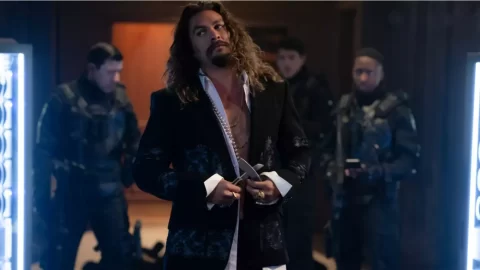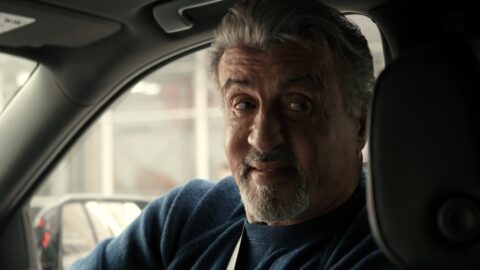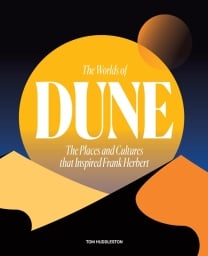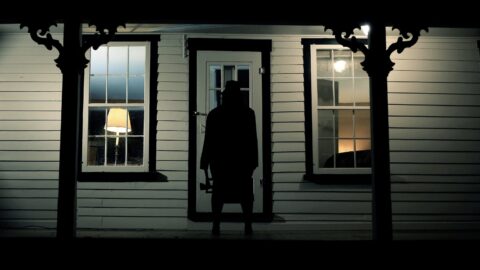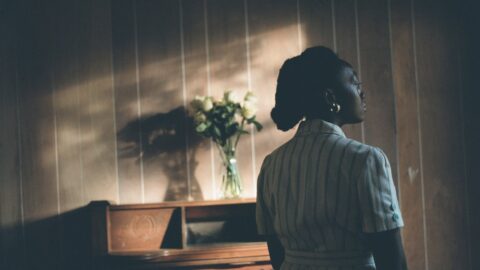From Harry Potter to Fast & Furious and “Bridesmaids,” Peacock has the hits you need to see (again).

Some days, it feels like there are too many streaming services and too many options. How can you possibly choose what movie to watch next?
For those of you who have Peacock (and why wouldn’t you? Their TV offerings are stacked!), we’re here to help. We’ve combed through the streaming service’s catalog to bring you the funniest comedies, the most moving dramas, the most suspenseful thrillers, and the all-around best movies for your viewing pleasure. All you need to bring is the popcorn!
1. Asteroid City
The most “Wes Anderson” of Anderson’s prolific and twee oeuvre, Asteroid City is not for everyone. If you’ve never found meaning in the stylistic artifice of an Anderson film, then you might feel similarly baffled here. But if Anderson’s whimsy has spoken to you in the past, then take comfort knowing this most recent offering might be his most intricate and affecting film to date.
Existential and gentle, Asteroid City is a movie about a show about a play, a nesting doll artistic endeavor keenly interested in the nature of storytelling. Is it about an alien encounter in a fictional desert town or the playwright and actors who brought the fictional desert town to life? Or is it about Anderson himself, an explainer on his hyper-specific body of work? The answer is all of this and more. Asteroid City is a fanciful, emotional triumph, popping off the screen with vibrant technicolor and a stacked cast of familiar faces and vibrant newcomers. A must-see film for Anderson-fans. — Kristina Grosspietsch, Freelance Contributing Writer
How to watch: Asteroid City is now streaming on Peacock.
2. Bridesmaids
Credit: Suzanne Hanover / Universal / Kobal / Shutterstock
If you haven’t seen Bridesmaids, written by Kristen Wiig and Annie Mumolo, we’re so sorry that you’ve obviously been trapped in a siren’s cave for the last 11 years — because there is simply no other excuse. Bridesmaids was an era-defining film. In 2011, there were still prominent male comedians claiming women couldn’t be funny! Bridesmaids put an end to the debate.
Wiig stars as Annie, a wayward thirtysomething who feels out of step with her best friend Lillian (a perfect Maya Rudolph) when she meets the other women in Lillian’s bridal party. What follows is both romantic comedy and buddy flick, stuffed to the brim with punchlines, physical gags, and a repulsive and unforgettable gross-out scene. The entire cast here is flawless: Rose Byrne is delightfully haughty. Jon Hamm is perfect as a hot idiot. Chris O’Dowd is a swoon-worthy love interest, and Melissa McCarthy was nominated for a dang Oscar for her scene-stealing performance as another misfit bridesmaid. Please escape the siren’s cave and see this legendary comedy — for your own good! — K.G.
How to watch: Bridesmaids is streaming on Peacock.
3. John Wick
Credit: David Lee / Thunder Road / Lionsgate / 87eleven / Mjw / Summit / Kobal / Shutterstock
Currently, all John Wick properties, including the so-so prequel series, The Continental, are streaming on Peacock. This highly stylized and violent neo-noir thriller franchise tells the story of John Wick (Keanu Reeves), the best assassin there ever was, who gets drawn back into the underworld after a personal tragedy leaves him set on revenge. Wick’s body count is prodigious and creative, but his cause is just. You can’t help but root for the quiet, brooding antihero. He wanted out of the game — but the game won’t let him say goodbye that easily. John Wick is a nonstop action spectacular with stunning cinematogaphy and positively mesmerizing fight choreography. — K.G.
How to watch: John Wick is now streaming on Peacock.
4. The Outfit
This cleverly twisted crime film was written and directed by Graham Moore, who won an Oscar for his adapted screenplay of The Imitation Game in 2015. The incomparable Mark Rylance stars as a soft-spoken British tailor who makes beautiful, bespoke men’s suits in 1950s Chicago. Unfortunately, most of his clientele are ruthless mobsters. The majority of the movie takes place in the span of one shocking and breathless night when his gangster clients seek shelter in the shop after an unexpected shootout from a rival organization.
The Outfit is a sophisticated and constantly surprising thriller. As Rylance’s assistant, Zoey Deutch is as charming as always, and Johnny Flynn thrives while playing against type as a no-good ’50s gangster. It’s an absolute gem of a film that will keep you guessing the whole way through. — K.G.
How to watch: The Outfit is streaming on Peacock.
5. Dayveon
Credit: Mama Bear Studios / Kobal / Shutterstock
Devin Blackmon stars as Dayveon, a young kid in Arkansas struggling in the aftermath of his brother’s death. Unmoored and spending his days listlessly wandering the little town he lives in, he is increasingly drawn to the sense of belonging he finds in a local gang. Directed by Amman Abbasi, with a script by Abbasi and Steven Reneau, Dayveon is a sophisticated and deeply intimate film made even more incredible by the fact that its cast is primarily composed of non-actors. It’s a moving and beautifully shot story that feels wholly, heartbreakingly real. — K.G.
How to watch: Dayveon is streaming on Peacock.
6. Girls Trip
Credit: Michele K Short / Universal / Kobal / Shutterstock
2017’s raunchy comedy about a group of friends traveling to New Orleans for the Essence Music Festival made Tiffany Haddish a household name. And once you watch the scene of her zip-lining above a partying crowd on Bourbon Street, you’ll know why. Written by Kenya Barris and Tracy Oliver, Girls Trip is boisterous, outrageous, and ridiculously lovable. The jubilant cast, starring Haddish, Regina Hall, Jada Pinkett Smith, and Queen Latifah, is clearly having so much fun celebrating female debauchery, it’s hard not to be on board with Girls Trip. — K.G.
How to watch: Girls Trip is now streaming on Peacock.
7. Trainwreck
Credit: Moviestore / Shutterstock
The mid-2010s brought us ombre hair, planking, and #YOLO, but its most enduring cultural addition was a wave of movies about imperfect women. More female-led films at the box office meant there was finally enough space for leading ladies who didn’t have to meet every standard to which we hold the modern women. Movie theaters were flooded with bad moms, antiheroines, and the sloppiest drunks you’ve ever seen in your life. Enter Trainwreck, a hilarious and irreverent rom-com directed by Judd Apatow and starring Amy Schumer in a role that’s basically her hot mess stand-up persona come to life.
In this hysterical comedy, Schumer and Bill Hader are surprisingly charming together as opposites attract. Plus, John Cena and LeBron James both add an unexpected sparkle to a fun and cheeky romance. — K.G.
How to watch: Trainwreck is streaming on Peacock.
8. Ip Man
Credit: Dreams Salon Culture / Pegasus Motion / Kobal / Shutterstock
Ip Man is an exciting Hong Kong martial arts biopic about the extraordinary life of the Wing Chun grandmaster who was Bruce Lee’s martial arts teacher. The film tracks Ip Man’s journey from the Southern Chinese village where he was well known as a skilled martial artist to his family’s displacement during the Japanese occupation of the Second Sino-Japanese War, his eventual rise as a fighter, and his establishment of a school in Hong Kong.
Starring the skillful Donnie Yen, Ip Man doesn’t skimp on character development; it’s an electrifying rumination on philosophy, power, and honor in addition to its stunning action. Ip Man is a deeply influential film in the martial arts genre and, to everyone’s delight, has inspired three equally stirring sequels, all of which are available on Peacock. — K.G.
How to watch: Ip Man is streaming on Peacock.
9. Harry Potter (the entire series!)
And now the franchise that needs no introduction: Harry Potter. The original eight-movie series starts as a charming coming-of-age tale about a boy wizard learning about magic and ends as a serious and emotional allegory about fighting fascism and the lengths we will go to protect the people we love. J.K. Rowling notwithstanding, Harry Potter is our hero, Ron Weasley our goofy best friend, and Hermione our actual hero, because duh.
The quality of the movies vary based on the different directors at the helm and the age of the young leads, but the strength of the source material — paired with the prodigious gifts of the many, many storied British actors who fill out the sparkling supporting cast — assure a satisfying watch. Most agree that the final two movies, each covering half of the last book in the series, are the most enthralling in the group — but you’ll have to watch them all to get what’s going on. So, you might as well start with number one, The Sorcerer’s Stone, and go from there. Poor you! You’re about to have a really great time! — K.G.
How to watch: Harry Potter is streaming on Peacock.
10. E.T. the Extra-Terrestrial
Credit: Patrick Rideaux / Shutterstock
You haven’t seen E.T. the Extra-Terrestrial, yet? So you’ve been politely laughing along every time someone has said “E.T. phone home” for the last 50 years?! It’s time to get on it already. E.T. the Extra-Terrestrial is a beloved family movie classic for a reason — it’s simply fantastic.
Steven Spielberg’s masterpiece tells the story of Elliott Turner, a 10-year-old who finds an alien in his backyard. With his siblings, he must help his new friend get back home or risk his being turned over to the government. It’s an exciting, heartwarming adventure that makes you feel like a kid again and inspired a half-century of copycats and homages (Stranger Things, anyone?). Despite being filmed five decades ago, E.T. the Extra-Terrestrial has not lost an ounce of its charm and emotional punch, a testament to its enduring quality. If you haven’t seen it, put E.T. at the top of your queue, immediately. — K.G.
How to watch: E.T. the Extra-Terrestrial is now streaming on Peacock.
11. Long Way North
This absolutely stunning, hand-drawn film hasn’t garnered as much attention as, say, Pixar’s latest, but that’s no reason to skip this immensely affecting French-Danish tale. Sasha (Christa Théret) is a 15-year-old aristocrat living in 19th-century St. Petersburg, Russia. Determined to find her missing grandfather, a famed explorer, and clear her family’s name, she locates a vessel and sets off with a motley crew into the unforgiving Arctic landscape.
Directed by Rémi Chayé, Long Way North is both an epic adventure and a human drama, exploring themes of empowerment and empathy. What truly makes this 80-minute movie special, though, is its unique artistic style. The snow-covered landscape might be stark, but Long Way North makes the icy world feel both beautiful and alive. — K.G.
How to Watch: Long Way North is streaming on Peacock.
12. Melancholia
Part of Lars von Trier’s “Depression Trilogy,” (which includes Antichrist and Nymphomaniac), 2011’s Melancholia is an artsy, atmospheric sci-fi thriller about the end of the world. A rogue planet is due to collide with Earth, and everyone must come face-to-face with the inevitable nothingness ahead of them. The cast is magnetic (Kirsten Dunst, Charlotte Gainsbourg, Alexander Skarsgård, and more) and the cinematography is unforgettable. A memorable, piercing rumination on grief that stands alone in its category. — K.G.
How to watch: Melancholia is now streaming on Peacock.
13. Back to the Future
Credit: Moviestore / Shutterstock
There’s no way you haven’t heard of 1985’s Back to the Future, the comedy science fiction romp — and honest-to-god American classic — that made the world fall in love with Michael J. Fox. Fox is Marty McFly, a bored teenager who befriends an eccentric scientist (Christopher Lloyd) and finds himself transported to the 1950s, where his presence threatens to wreak havoc on the future. Marty has to make sure his parents still fall in love, or he’ll be wiped from history forever. It’s a fantastic premise that somehow never feels absurd thanks to the Fox’s aching humanity and Lloyd’s charisma. From the very first utterance of “Great Scott!” we’re along for the ride on a journey where we won’t need roads. — K.G.
How to watch: Back to the Future is now streaming on Peacock.
14. Forgetting Sarah Marshall
Credit: Apatow Productions / Kobal / Shutterstock
Jason Segel is Peter, a television soundtrack composer whose life revolves around his TV star girlfriend, Sarah Marshall (a deliciously bratty Kristen Bell). That is, until she abruptly breaks up with him. While he’s naked. Cue the full-frontal sobbing!
To get his mind off of her, Peter takes a trip to Hawaii, but turns out, Sarah is vacationing at the same resort with her new rock star boyfriend, Aldous Snow (unfortunately played by Russell Brand). Forgetting Sarah Marshall is a sweet and raunchy breakup rom-com full of characters that are flawed, idiosyncratic, and incredibly human, including Mila Kunis as Peter’s cool new love interest and Paul Rudd as a hippie-dippie surf instructor. And let’s not forget the singing vampire puppets! — K.G.
How to Watch: Forgetting Sarah Marshall is streaming on Peacock.
15. Emma
A sumptuous and charming adaptation of the Jane Austen novel, 2020’s Emma is unique among Emma iterations because it leans into a secret truth: the heroine, Emma Woodhouse, is kind of a brat. She floats above everyone else, pulling strings to set up matches that serve her purposes instead of what her friends actually desire. Clueless always understood this — and now, thanks to director Autumn de Wilde, we can watch the naive and loveably self-centered character face her comeuppance while sporting the dazzling Regency-era costumes she was made for. Anya Taylor-Joy hits all the right notes as Ms. Woodhouse herself, and Johnny Flynn is magnetic as Mr. Knightley, her prickly neighbor who sees through her act. But it’s Josh O’Connor as a delightfully offputting Mr. Elton, a nightmare suitor, who steals every scene he’s in. — K.G.
How to watch: Emma is now streaming on Peacock.
16. Frankenstein
Most of pop culture’s most enduring monsters — Dracula, Frankenstein, the Mummy, and the Wolf Man/Werewolf — got their first screen time in Universal Studios films made between the 1930s and 1950s. These incredibly influential classic horrors are the reason we all picture a square-headed Frankenstein and a Dracula with an indulgently high collar. The first impression is the one that sticks.
Peacock is still home to most of the Universal Classic Monsters, including The Bride of Frankenstein, The Invisible Man Returns, Werewolf of London, Phantom of the Opera, and more. None are as iconic, however, as 1931’s Frankenstein, starring Boris Karloff as Dr. Frankenstein’s monster. The story, adapted from Mary Shelley’s 1818 novel, Frankenstein; or, The Modern Prometheus, is one so well-known it does not need repeating, but if you were wondering where the almost-full century of film and TV jokes about little girls befriending villains came from, look no further. This is the movie that turned a monster into a legend. — K.G.
How to watch: Frankenstein is now streaming on Peacock.
17. Man on Wire
In 1974, Philippe Petit walked a high wire between the two towers of the World Trade Center in NYC. Petit was later arrested for the stunt. In 2008, documentarian James Marsh made Man On Wire, a moving, awe-inspiring chronicle of Petit’s audacious feat, based on Petit’s own book about the event. Suspenseful, mischievous, and paced like a heist movie, Man On Wire is a riveting watch sure to keep even the most ardent documentary-avoider on the edge of their seats. — K.G.
How to watch: Man on Wire is now streaming on Peacock.
18. How to Train Your Dragon
Hiccup (Jay Baruchel) doesn’t quite fit into his dragon-fighting viking village of Berk. The seasoned warriors, including his father, the chief (Gerard Butler), think he’s too much of a weenie to fight their fearsome dragon enemies. But Hiccup has a secret: He’s found a wounded dragon who has quickly become his best friend. Will his village change its mind about dragons, or will Hiccup and his dragon be forced to hide for the rest of their lives? It’s a fun family romp that makes the incredibly smart choice of giving dragons the eager, earnest personalities of everyone’s favorite family dog. It doesn’t matter how old you are, Dreamworks’ How to Train Your Dragon is a total treat! — K.G.
How to watch: How to Train Your Dragon is now streaming on Peacock.
19. Traffic
The movie that won Steven Soderbergh the Academy Award for Best Director, Traffic is a complex, captivating exploration of drug trafficking in the USA and Mexico. Following multiple intersecting storylines, audiences watch the effects of illegal drugs ripple in all directions, from manufacturers and distributors to the politicians trying to combat them and the users who are hooked. Shot like a documentary and including multiple cameos from actual U.S. congresspeople, Traffic is a riveting, powerful piece that feels utterly real.
What’s more, the cast is stellar, with Michael Douglas, Don Cheadle, Dennis Quaid, Catherine Zeta-Jones, and Luis Guzmán all at the top of their game, and Benicio Del Toro in particular winning the Academy Award for Best Supporting Actor for his role as a Mexican police officer. — K.G.
How to watch: Traffic is now streaming on Peacock.
20. The Northman
Alexander Skarsgård plays a viking in “The Northman.”
Credit: Focus Features
Written and directed by Robert Eggers (The Witch, The Lighthouse), The Northman is a dark, suspenseful retelling of a Scandinavian myth that also happens to have been the direct inspiration for Shakespeare’s Hamlet. Alexander Skarsgård is Amleth, a young prince who swears revenge after his uncle murders his father and marries his mother. Years later, now a berserker Viking, Amleth has an encounter with a seer that convinces him the time to collect on that childhood promise is nigh.
The Northman is a tense, atmospheric, and brutal historical thriller, told as if it were a story recounted around a medieval Scandinavian fire, grounded in an ancient point of view. This visually-stunning but bloody revenge saga also stars Nicole Kidman, Claes Bang, Anya Taylor-Joy, Gustav Lindh, Ethan Hawke, Willem Dafoe, and Björk, obviously.* — K.G.
How to watch: The Northman is now streaming on Peacock.
21. Point Break
Point Break is an iconic and insane ’90s movie in which Keanu Reeves plays rookie FBI agent Johnny Utah, who has to — and we’re not kidding here — infiltrate an L.A. “surf gang” suspected of robbing banks. Very little in this movie makes any sense (the large reason Utah is assigned the undercover role is because he used to play football in college?), which is exactly why it’s so dang wonderful. You’ve got Patrick Swayze as the enigmatic leader of a surfing cult, Gary Busey as Reeves’ gruff veteran partner, and again, Keanu Reeves plays a former college football star named Johnny Utah who has to learn to surf as a matter of life and death. Point Break is ludicrous, magnificent, and fantastically, perfectly ’90s. Vaya con dios, baby. — K.G.
How to watch: Point Break is now streaming on Peacock.
22. Fast X
Credit: Peter Mountain / Universal Pictures
If loving Fast & Furious is wrong, we don’t want to be right. Across 11 bonkers movies that scoffed at physics and grunted about the importance of family, this franchise hasn’t slowed down. Not only has it raised the bar on out-of-this-world action, but also, it’s grown the Fast family by leaps, bounds, and long-lost siblings. So what could Fast X possibly do to keep this momentum going strong? It went hard in every way fans demand.
In the tradition of its predecessors, Fast X retcons to bring a new ferocious foe into the fray. Jason Momoa stars as the flamboyant, fashion-forward, and gleefully anarchistic Dante, who’s seeking revenge against Dom Toretto (Vin Diesel) and all of his extensive family. Momoa is wild fun as a villain who is Dom’s polar opposite in attitude and outfit choices. That alone is enough to enjoy this ride. But Fast X also includes gonzo fight scenes with the likes of Brie Larson, Charlize Theron, Jason Statham, Sung Kang, and many, many more. There are also jaw-dropping cameos and a climax that had fans shocked and cheering. The only thing not to like about this one is how it left us hanging, waiting for whatever Fast and Furious 11 might bring.* — Kristy Puchko, Film Editor
How to watch: Fast X is now streaming on Peacock.
(*) denotes writeup came from a previous Mashable list.
UPDATE: Oct. 31, 2023, 2:18 p.m. EDT This article has been updated to reflect Peacock’s current streaming selection.









